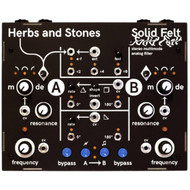Solid Felt - Herbs and Stones
by Jason Czyeryk
There are many reasons to like Herbs and Stones desktop stereo multimode filter, Solid Felt. With multiple use cases (dual mono 12dB/Oct filters, turning a mono signal into stereo signal…), and sporting a bunch of CV inputs for modulation, Solid Felt opens up a lot of doors. Powered via a 9V power adapter (not included), and housed in a sturdy black PCB case, Solid Felt is a nice-looking machine, clearly labeled with slightly whimsical aesthetics (the knob for the Mode is the “O” in mode, for example) similar to Herbs and Stones’ other devices and modules and mostly symmetrical in look and layout. There are ¼” ins and outs on the back, so right off the bat Solid Felt definitely doesn’t seem to be intended solely for modular/synth use, though there are sixteen 3.5mm CV inputs for modulation throughout. With two filters—A and B—one on each side of Solid Felt, they are divided by the center portion of the device, which consists of an envelope follower, clock divider, two LFOs, and a routing section. Both channels have an Input Gain control that can venture into diode clipping territory and you can select from LP, BP, or HP filter modes with the Mode Control, with a CV In for modulation. Each channel also has controls for Frequency and Resonance, with a CV In for the Frequency.
The middle section is sort of a hodge podge—a who’s who—of modular utilities: an envelope follower (follows Input A) with a “Feel” control, a clock divider section with ÷2, ÷4, ÷8 outputs, and two onboard LFOs. LFO1 has controls over Rate and Shape, though you can patch in an external signal to set the LFO rate as well. The shape of the LFO goes from triangle to square and points in between, though it doesn’t actually put out a perfect triangle wave; instead, it’s a morph between a triangle and a sine wave with a peaky bottom and a curved top (unless it’s flipped, in which case, it’s the other way around); and the square wave also wasn’t exactly a square wave, sporting curved edges, not right angles. None of this bothered me in the least, and I rather liked the peculiarities of LFO1 as the shapes lend themselves well to frequency modulation of a filter. LFO1 also has 0° and 180° out-of-phase outputs and a 180° inverse CV In, which allows a gate signal to literally turn things upside down at the 180° output. LFO2 is a bit more simple than LFO1, with only controls for Rate and a CV In, and 0° and 180° outs for falling sawtooth waves. At the very bottom of the device there are bypass buttons for each channel—more akin to guitar pedals than Euro modules—that worked opposite of what I expected: the signal is bypassed on the “out” position of the button, rather than the “in”. A/B routing buttons allow you to run Filter A in series through B, use A and B in parallel even with just a signal at Input A, or work as two separate12dB/Oct filters. You can also bypass both filters to use Solid Felt for its distortion, giving some flair to your signals. It was pretty fun to engage/disengage the filters in this manner with everything patched up, and I was surprised at how much versatility was gained from simply using the bypass buttons.
With the routing possibilities, I found much success with running A and B in parallel with one signal patched into Channel A (nothing in B) and panned hard left and right in the mixer. I really love stereo spread with filter effects, and modulating each channel’s filter to sweep in sync and out of sync with each other rules. What else rules? How Solid Felt processes sound. Crackle distortion, pure grit, adding rough edges, Solid Felt sounds great when pushed. I got plenty of hollowed out nasally whining with resonance/s up high, and some good ol’ nasty dirt with the Input Gain cranked as well. One thing that must be done (!) with a dual filter is creating a variable band-pass filter and then CVing each filter's frequency for some movement, to shift the cutoff points. Doing this with the internal LFOs was cool, and using the envelope follower to modulate either filter’s frequency or other modules in the chain was nice to have, though I prefer the bipolar modulation of a -5V to +5V LFO for filter modulation, and the onboard modulation on Solid Felt is only unipolar—only positive. Of course the unipolar modulation works perfectly for modulating the modes of the filters, and here you can get even more movement and variation, and really warp your sound.
Placing the two filters in series gives you a 24dB/Oct filter; although it doesn’t have quite the drastic drop of a certain famous ladder filter of the same octane. It’s really the way that Solid Felt distorts and destroys your signal in such a menacingly pleasing way, and the cool stereo configurations that makes this such a fun unit.
I definitely like the way it handles sound, whether you’re utilizing the filters to add character to your signal—subtle or not so—or just using it as a stereo effect for overdrive. Running drums—and especially basslines—brought a lot to the table. While there are some peculiarities to Solid Felt—I do think it would make an excellent dedicated Eurorack module (maybe even more so than a tabletop device)—I can see why Herbs and Stones went this route, designing it to live on a flat surface or stand, as it’s a totally playable single/dual filter/distortion unit, and fits in well in an atmosphere of other tabletop devices.
Price: $529
herbs---stones.com


